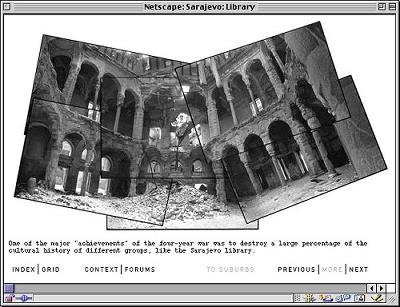5. Case History
2.
Gilles had not worked on the Web before - for him the film and the book
were the most productive structural metaphors as starting places. After
looking at and discussing the month-and-a-half worth of photographs that
Gilles had taken in and around Sarajevo as Muslims were moving back into
their own neighborhoods and Serbs were moving away, responding to well-intentioned
United Nations directives and to sinister rumors of potential genocide
that were floating about, we decided upon the metaphor of the journalist
as the operative strategy for the reader. The reader would be required
to click on images, unaware of what was next, comparing information, taking
trips and side trips through photographs, text, sound and video, removing
themselves from the journalistic representations to go to one of 14 forums
to participate in discussions of the events (introduced by UN Ambassador
Madeline Albright, CNN’s Christiane Amanpour and human rights activist
Aryeh Neier, among others), or to look at maps and other archival material
provided by the Times and National Public Radio.
The navigational devices for each screen, in these early days of the Web,
were discussed for weeks as we aimed for simplicity, short download times,
and the ability to explore aspects of the narrative with greater complexity
(we had a “More” button). Two screens of small photographs were
provided to function as “contact sheets” allowing the reader
to go to any part of the reportage without following the various pathways
that we had set up.

The photography was discussed and reevaluated in Web terms - we could give 360-degree looks at things, we could use complex images to serve as multiple links, we could scroll sideways or up and down, we could create collages, etc. We decided to accompany Gilles’s photographs with his own written text and his voice expressing more of his emotional reactions and philosophical questions. We were also in contact with numerous people in Bosnia, the UN and elsewhere trying to find other ways of telling the story - dispatches (from stringer Kit Roane), post cards, historical pictures (provided by Times editor Mark Bussell), maps, etc.